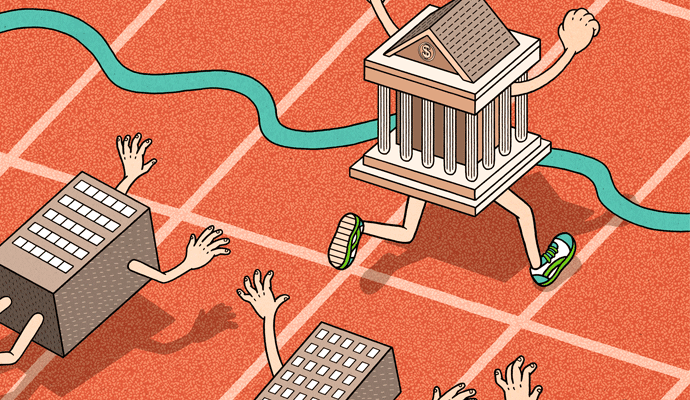The “Quality Shortfall” in Bank Ratings
Are decisions affected by potential conflicts of interest that credit-rating agencies engender?
Title: Bank Ratings: What Determines Their Quality?
Authors: Harald Hau (University of Geneva), Sam Langfield (European Central Bank), and David Marques-Ibanez (European Central Bank)
Publisher: European Central Bank Working Paper No. 1484
Date Published: October 2012
The credit ratings assigned to banks in the United States and Europe are generally poor predictors of whether the banks will default in the near future, according to this paper. The study also finds empirical evidence that agencies systematically give large banks better ratings than they give their smaller counterparts. This appears to happen because of the extensive business relationships between the banks and the agencies that assign grades, which leads the agencies into potential conflicts of interest.
The quality and efficacy of credit ratings have come under criticism in the wake of the recent financial crisis; many banks had been granted investment-grade status before defaulting or even failing. The debate over the ratings — and how agencies arrive at their particular grades for banks — thus became part of the larger conversation about financial regulation. More than half of all corporate bonds are held by institutions that are subject to ratings-based investment restrictions, a fact that underscores how crucial the agencies’ grades are to the financial system.
Calling their study “the most comprehensive analysis of bank rating quality so far,” the authors examined almost 39,000 quarterly bank ratings from 1990 to 2011 from the three major agencies: Standard & Poor’s, Moody’s, and Fitch. For each bank, they cross-checked the data on credit ratings against yearly accounting information and monthly expected default frequencies (a widely used measure of bank distress) from Moody’s KMV database.
The authors note that their intention was not to hold rating agencies to an impossible benchmark of accuracy, but to the weaker standard of consistency for their bank ratings over time. Accordingly, the authors ranked the banks first by their credit rating and then by their expected default frequency two years later. The difference between these two rankings is the “quality shortfall.”
Several key findings emerged. The first concerned the overall quality of the ratings, which were generally poor indicators of banks’ future problems. In noncrisis periods, credit ratings were predictive of future expected default probabilities only for the lowest quartile of the banks, those with ratings of BBB+ and below. The results imply that a bank with an A rating is just as likely to become distressed as one with an AAA rating, the authors write.
The authors found that the accuracy of credit ratings increased only a bit during crises; if the banks’ expected risk of default was calculated during a period of financial upheaval, the ratings were slightly more informative.
Second, large banks were systematically favored in the ratings, the analysis showed. For banks in the upper investment-grade range, the ratings bore no significant relationship to the probability that they would default two years down the road, and large banks received consistently better ratings relative to their expected risk of default. The authors note that this outcome runs contrary to the assumptions underlying much of the recent legislation in this area, which has assumed that bank ratings would allow regulators to carefully weigh their risks.
The authors propose that this systemic bias favoring large banks is most likely related to the ongoing relationships between rating agencies and financial institutions. The potential for conflicts of interest tends to increase as a bank grows in size and economic might. The authors say that big banks with significant financial clout might be “too big to downgrade” for a rating agency. And although this distortion in ratings for large banks could be tied to the government guarantees they receive, the authors controlled for that variable and still found a ratings bias toward big institutions. Finally, this bias has an economically meaningful effect: It corresponds to unwarranted rating improvements from A– to A, a jump that significantly reduces big banks’ financing costs.
“Overall, the rating bias distorts the financing costs of large banks and reinforces the creation of ‘too big to fail banks’ devoid of economic rationale,” the authors say.
In a third finding, the results revealed conflicts of interest between banks and agencies related to their other business relationships.
“The more a bank used a particular rating agency for rating its asset-backed securities at issuance, the more this agency rewarded the bank with a better bank credit rating,” the authors write, noting elsewhere in the paper that the rating process “is probably compromised by overlapping business interests between rating agencies and large banks.”
In light of these shortcomings, the authors suggest, investors should seek out alternative sources of credit rating information. A couple of recent studies have shown that corporate credit rating measures that are at least as accurate as those from agencies can be produced at no cost, using public information. The authors propose enhancing the scrutiny of large banks, and urging them to make more public disclosures. “Better public information and more bank reporting is the best strategy to reduce the exorbitant influence of rating agencies in the current financial system,” they say.
Finally, the authors note that the 2010 Dodd–Frank Act, which is designed to decrease regulators’ reliance on rating agencies, will most likely encourage the emergence of alternative rating agencies (including nonprofit or low-cost agencies) in the U.S. But elsewhere, that is less likely to happen. In most countries, the authors write, comprehensive data on banking results is kept from the public and even from many regulators.
Bottom Line:
Credit rating agencies assign better ratings to large banks, resulting in economically significant outcomes that help perpetuate the “too big to fail” phenomenon. This appears to be a result of potential conflicts of interest between the ratings agencies and the banks. Overall, the credit ratings assigned to banks have typically been poor indicators of whether they would default in the near future.



